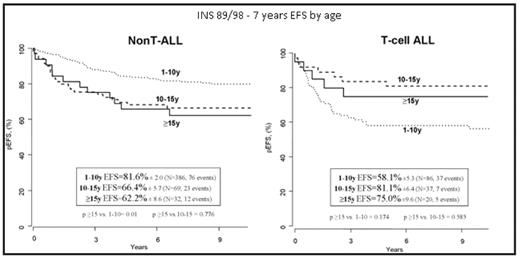Abstract
The outcome of adolescents (≥ 15 years old) with ALL treated on contemporary pediatric ALL protocols has improved and compares favorably with the results of adolescents treated on adult protocols. However, the overall outcome of adolescents is still inferior to that of young children. In order to analyze this difference we compared early response to treatment and biological characteristics of various ALL subtypes (T-cell and non-T-cell), in these age groups. Between January 1989 and June 2008, a total of 942 patients, i.e.,83 (9%) aged ≥ 15 years, 162 (17%) aged 10<15 years and 697 (74%) aged 1<10 years, were enrolled in three ALL Israeli National Studies: INS-89/98 and INS 2003, based on the modified ALL-BFM 90/95, and ALL IC-BFM 2002, respectively. The 7-year event free survival (EFS) and overall survival (OS) in the ALL-INS 89/98 study for the age group of ≥ 15y were 67.1% (± 6.6%) and 66.4% (±6.7%) respectively, compared to 77.3% (±1.9%) and 83.4% (±1.7%) for the age group of 1<10y (p=0.132, p=0.008) respectively. No difference in either EFS or OS was found between the ≥ 15y and 10<15y age groups. In adolescents the incidence of T-ALL was higher compared to that in young children aged 1<10 y (36% vs 18 %;p<0.0001) and similar to the incidence seen in the 10<15y group (30%; p=0.35). In T-ALL no difference in EFS (Fig), relapse rate, or OS, were observed among the age groups. No major differences were seen in patient characteristics, including gender, WBC at diagnosis, BFM-risk factor (RF) and early response to prednisone. In contrast, in the B-lineage ALL, the outcome of adolescents was significantly inferior compared to that in young children (1–10y) in terms of EFS (Fig) and OS [61.4% (± 8.8%) vs 88.1% (±1.7%)(p=0.000)], with a higher relapse rate [25% (± 7.9%) vs 14.5% (±1.8%) (p=0.15)] and higher incidence of death in induction. No significant difference in the outcome was noticed between the ≥ 15y and 10<15y age groups (Fig). Adolescents with B-lineage ALL, when compared to younger patients (1–10y), had increased incidence of males (p=0.016)) and showed a higher WBC count at diagnosis (p=0.061), CNS involvement (p=0.0008), CALLA negative immunophenotype (p=0.002), and trend for poor response to prednisone. Cytogenetic analysis revealed that patients from the ≥ 15y group had a much lower incidence of favorable genetic subgroups: TEL/AML1+ and high hyperdiploidy (>50 chromosomes), higher incidence of Philadelphia chromosome, and normal karyotype compared to younger patients (1<10 y) (p=0.0064). In conclusion: In adolescents the higher incidence of unfavorable biological features in B-lineage ALL could contribute to their inferior results compared to young children. In T-cell ALL, no difference was demonstrated either in the outcome or biological characteristics, among the age groups of patients receiving the ALL-INS treatment (BFM backbone).
Supported by the Israeli Cancer association
Disclosures: No relevant conflicts of interest to declare.
Author notes
Corresponding author


This feature is available to Subscribers Only
Sign In or Create an Account Close Modal